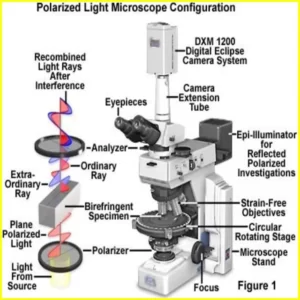Light Microscope- Best Definition
We all know the importance of being able to see detail in everything – from observing microscopic organisms up close to examining the intricate details of an artwork. In this article, we will explore what a light microscope is, its principle and different types, as well as its many applications and uses. So read on for a comprehensive guide to the fascinating apparatus of the light microscope.
What is a light microscope?
A light microscope is an optical instrument that uses visible light and a system of lenses to magnify images of small objects. The light microscope is the oldest type of microscope and was invented in the 1600s.
The basic principle of a light microscope is that when light passes through a medium, it bends (refracts). This principle is used in all types of microscopes, including the compound light microscope, which is the most common type of microscope used in research laboratories.
Compound microscopes have two sets of lenses: the objective lens, which is closest to the object being viewed, and the ocular lens, which is closest to the eye. The ocular lens magnifies the image formed by the objective lens. Most compound microscopes have multiple objective lenses that can be swapped to change the magnification power.
Light microscopes are used for a wide variety of applications, including studying cells and bacteria, examining minerals and crystals, and viewing insects and other small animals.
Article About:- Health & fitness
Article About:- Medical Technology
Article About:- IR News
Article About:-Amazon Product Review

Working Principle of the light microscope
The principle of the light microscope is simple. The instrument uses a system of lenses to magnify an object so that it appears larger than it actually is. The first lens, called the objective lens, is positioned near the object being viewed. The second lens, called the ocular or eyepiece lens, is located near the eye of the person viewing the object.
The objective lens collects light from the object and focuses it into a real image. This image is magnified by the ocular lens before reaching the eye. The degree of magnification is determined by the ratio of the focal lengths of the two lenses. A low-power objective lens with a long focal length can be used in conjunction with a high-power ocular lens with a short focal length to achieve high magnification.
Types of light microscopes
There are four main types of light microscopes: compound, stereo, phase contrast and fluorescence.
Compound microscopes are the most common type of microscope. They use a series of lenses to magnify objects. The first lens is the objective lens, which is located near the object being observed. The second lens is the eyepiece, which is located near the viewer’s eye.
Stereo microscopes have two eyepieces and two objectives. This allows for three-dimensional viewing. Stereo microscopes are often used for the inspection of small objects such as insects or coins.
Phase contrast microscopes use a special type of lens that enhances the contrast of objects that would otherwise be difficult to see. This makes them ideal for viewing living cells.
Fluorescence microscopes use special filters and light sources to make certain objects appear fluorescent, or luminous. Fluorescence microscopes are often used in medical research to examine cells and tissues.
Uses for a light microscope
A light microscop is a type of microscope that uses visible light and a system of lenses to magnify images. The earliest known microscope was made in 1595 by Zacharias Janssen, a Dutch spectacle maker. His design consisted of two convex lenses in a single tube.
The first practical use of the light microscop was found in the work of Antoine van Leeuwenhoek, a Dutch draper, who used a single-lens microscope to study fabric samples and observe tiny organisms living in water droplets. In 1674, Robert Hooke used a compound light microscope to discover cells in cork tissue. This discovery led to a greater understanding of the cellular structure of plants and animals.
Today, light microscop are widely used in research laboratories and classrooms around the world. They are essential tools for biologists studying cells and other small specimens. Compound light microscopes can be equipped with various accessories, such as cameras and fluorescence illuminators, to allow photography and specialized imaging techniques.




















